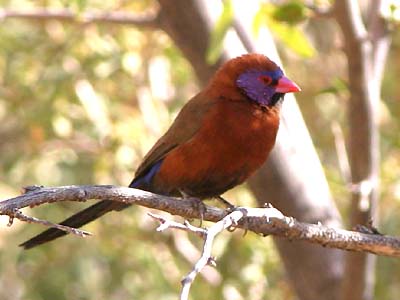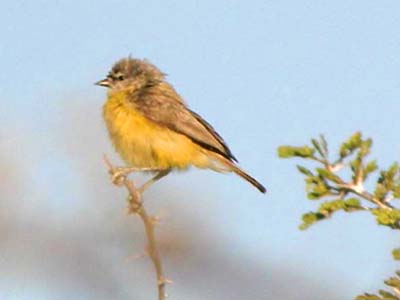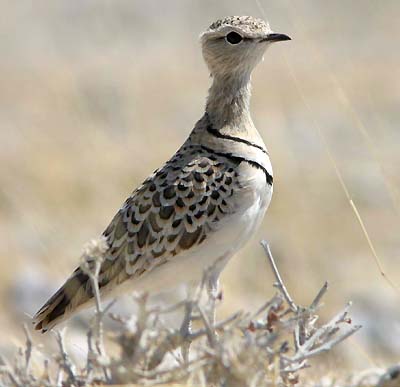Daily Journal
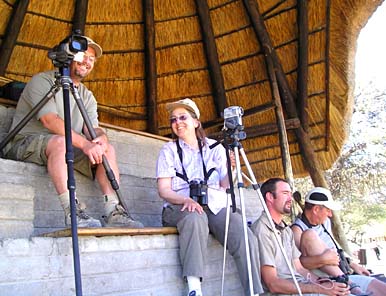 Day
20 (19 July): Last night herds of Elephant, Springbok, Wildebeest,
and 7 Black Rhino had come to Okaukuejo waterhole. Today we moved our lodging
to a comfortable and convenient bungalow within steps of the floodlit waterhole.
We bought food at the little store and cooked our own dinner, washed down
with a nice '02 Nederburg Cab-Merlot we had purchased in Windhoek.
Roars of Lion would prompt us out to see the action throughout the night;
three Lion spent most of the night hanging about and half-heartedly chasing
Giraffe, but they quickly moved aside for the parade of 11 Black Rhinos
— mostly mothers and calves of various ages — that trekked to the water
during the evening. One little set of 'bleachers' (right) made for excellent
viewing, and we ended up spending much of the afternoon and evening here. Day
20 (19 July): Last night herds of Elephant, Springbok, Wildebeest,
and 7 Black Rhino had come to Okaukuejo waterhole. Today we moved our lodging
to a comfortable and convenient bungalow within steps of the floodlit waterhole.
We bought food at the little store and cooked our own dinner, washed down
with a nice '02 Nederburg Cab-Merlot we had purchased in Windhoek.
Roars of Lion would prompt us out to see the action throughout the night;
three Lion spent most of the night hanging about and half-heartedly chasing
Giraffe, but they quickly moved aside for the parade of 11 Black Rhinos
— mostly mothers and calves of various ages — that trekked to the water
during the evening. One little set of 'bleachers' (right) made for excellent
viewing, and we ended up spending much of the afternoon and evening here.
During the morning we had a fine game drive through thorn
scrub and plain that netted a variety of new trip birds, including Lappet-faced
Vulture and African Hawk-Eagle, plus lifer Chestnut-backed
Sparrow-Lark was scoped among flocks of Gray-backed at the waterhole.
Day 21 (20 July): Before breakfast
we did a game drive back toward to main western entrance, and came upon
a lifer Southern Penduline-Tit, After breakfast we headed
towards Halali Camp in the center of Etosha NP. We mostly followed the
edge of Etosha Pan, crossing dry plains and turning into waterholes here
and there, coming upon large herds of zebra, scattered Greater Kudu and
Impala, and a small herd of Elephant. Superb views of Kori,
Ludwig's, and White-quilled Bustards were highlights, and we
found what may prove to be the Etosha Rock Agama, a very localized
endemic lizard. At a bathroom stop the women's restroom played host to
a Slit-faced Bat — new for all of us.
We arrived at Halali Camp at 2 pm and made our own lunch
of spaghetti. Walking through the camp we came upon a small flock of Bare-cheeked
Babbler — the only ones we would find on the trip — just as they tucked
into a tight huddle to sleep away the afternoon. The waterhole here didn't
have much (an occasional Elephant for us, although other tourists told
us that huge herds came in the next day). At dusk, Richard called in an
African Scops-Owl to a tree within a few feet of our chalet. It was the
most strenuously 'owling' we would do on the whole trip.
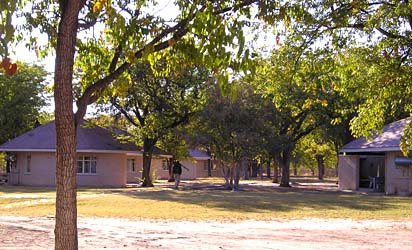 Day
22 (21 July): We checked Halali waterhole early, and had a confiding
Red-necked Falcon and our only Spotted Hyena of the trip. Then, while walking
to breakfast through the scattered trees among the individual chalets
at Halali (right), I found a roosting Southern White-faced Owl.
After breakfast, we headed off to the east end of the park and headquarters
at Namutoni Camp, finding a Carp's Tit enroute, arriving mid-day.
We chose to take this afternoon off, to nap and walk the grounds a bit,
and do more laundry. We went to the waterhole at the edge of this camp
several times, but it sucked. New birds in camp, though, included
Red-billed
Francolin and Burnt-necked Eremomela. Day
22 (21 July): We checked Halali waterhole early, and had a confiding
Red-necked Falcon and our only Spotted Hyena of the trip. Then, while walking
to breakfast through the scattered trees among the individual chalets
at Halali (right), I found a roosting Southern White-faced Owl.
After breakfast, we headed off to the east end of the park and headquarters
at Namutoni Camp, finding a Carp's Tit enroute, arriving mid-day.
We chose to take this afternoon off, to nap and walk the grounds a bit,
and do more laundry. We went to the waterhole at the edge of this camp
several times, but it sucked. New birds in camp, though, included
Red-billed
Francolin and Burnt-necked Eremomela.
Day 23 (22 July): Our final morning
in Etosha was productive with a little drive around 'Dik-Dik Loop.' Not
only did we encounter the namesake Damara Dik-Dik, but we got views
of a Ratel (not great views, but views nonetheless). After breakfast
we headed northeast towards the Caprivi Strip. That is a narrow strip of
land by which Namibia stretches east almost to Victoria Falls, a left-over
from colonial times. Today it is filled with people (a fair number are
refugees from the Angola war) and the habitat badly hacked up. Enroute
we stopped in thorn-scrub at Roy's Camp, and were given permission to bird
the grounds a bit [we would have stayed there when coming back at the end
of the trip but Roy's was fully booked]. The highlight bird here is Black-faced
Babbler, our only ones of the trip.
When we reached the Caprivi Strip we entered a new habitat:
deciduous broadleaf woodland. As our visit was in mid-winter it was birding
through an oak woodland in winter in California, except for the thicker
grass understory. There were very few birds during our mid-day visit, but
what we saw included new species for the trip list [e.g., Dark Chanting-Goshawk,
Wood Pipit], and Richard flushed a nightjar to a bare tree limb. We
viewed it in the scope and found it had a rufous collar but almost no white
in the tail. It was a female of either Fiery-necked Nightjar or Rufous-cheeked
Nightjar, and some characters suggested the latter. However, all Rufous-cheeks
should be north in the Congo Basin at this date while Fiery-necks are resident
(indeed, we would hear them later at night). So it probably was a Fiery-neck. |


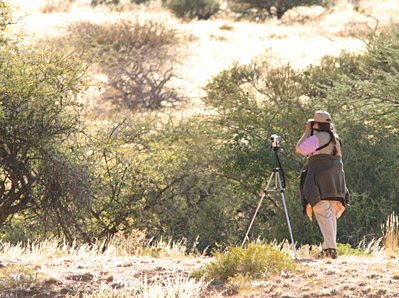

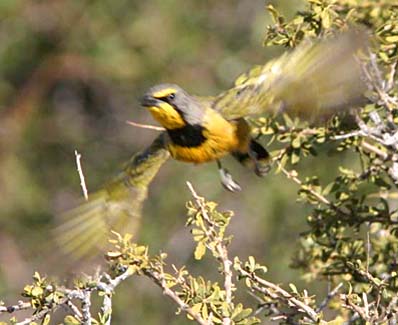
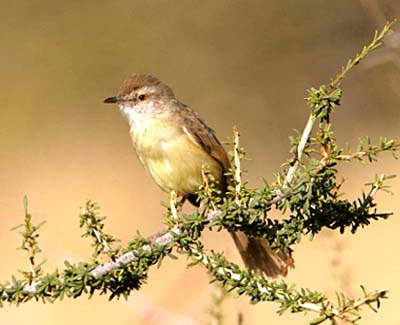
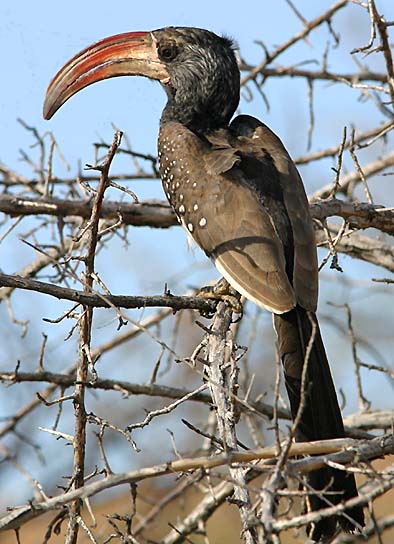
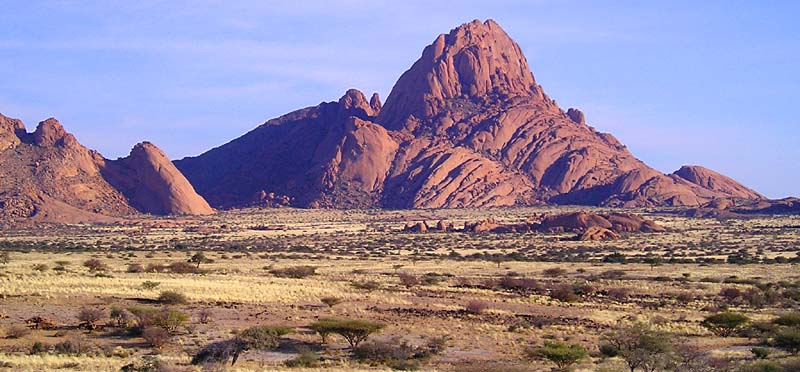
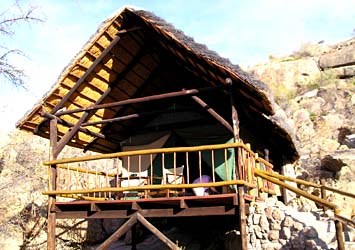 There was plenty of wildlife around Erongo Wilderness Lodge, and particularly
many Rock Hyrax. Each individual chalet was actually a fancy tent with
a hardwood floor and full bathroom, cleverly inserted among huge boulders
(right). The food and drinks were superb; it was a treat to relax on our
balcony, sipping a fine wine, and watch the sun go down over the desert.
There was plenty of wildlife around Erongo Wilderness Lodge, and particularly
many Rock Hyrax. Each individual chalet was actually a fancy tent with
a hardwood floor and full bathroom, cleverly inserted among huge boulders
(right). The food and drinks were superb; it was a treat to relax on our
balcony, sipping a fine wine, and watch the sun go down over the desert.
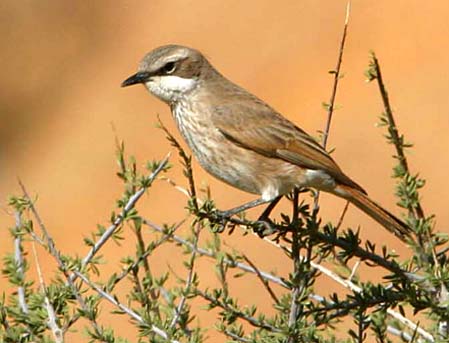

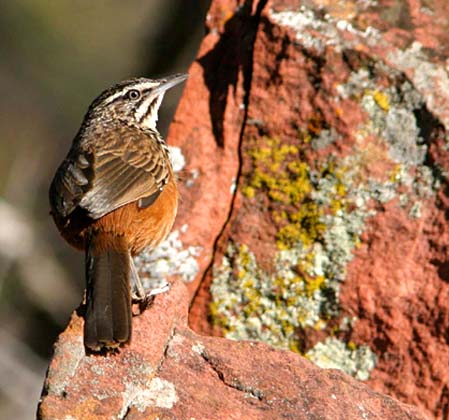


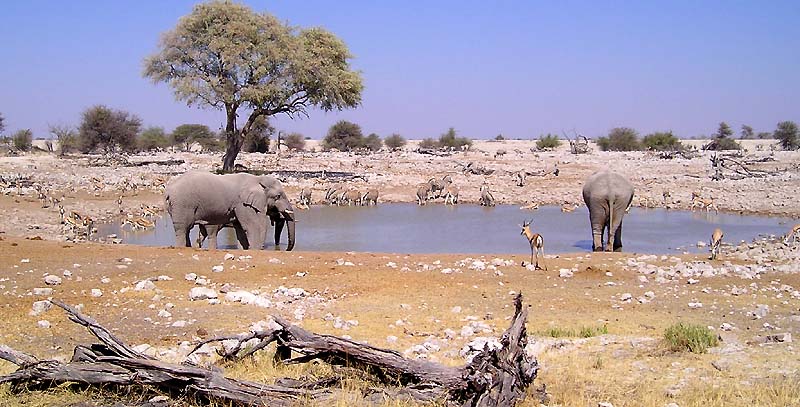

 Day
20 (19 July): Last night herds of Elephant, Springbok, Wildebeest,
and 7 Black Rhino had come to Okaukuejo waterhole. Today we moved our lodging
to a comfortable and convenient bungalow within steps of the floodlit waterhole.
We bought food at the little store and cooked our own dinner, washed down
with a nice '02 Nederburg Cab-Merlot we had purchased in Windhoek.
Roars of Lion would prompt us out to see the action throughout the night;
three Lion spent most of the night hanging about and half-heartedly chasing
Giraffe, but they quickly moved aside for the parade of 11 Black Rhinos
— mostly mothers and calves of various ages — that trekked to the water
during the evening. One little set of 'bleachers' (right) made for excellent
viewing, and we ended up spending much of the afternoon and evening here.
Day
20 (19 July): Last night herds of Elephant, Springbok, Wildebeest,
and 7 Black Rhino had come to Okaukuejo waterhole. Today we moved our lodging
to a comfortable and convenient bungalow within steps of the floodlit waterhole.
We bought food at the little store and cooked our own dinner, washed down
with a nice '02 Nederburg Cab-Merlot we had purchased in Windhoek.
Roars of Lion would prompt us out to see the action throughout the night;
three Lion spent most of the night hanging about and half-heartedly chasing
Giraffe, but they quickly moved aside for the parade of 11 Black Rhinos
— mostly mothers and calves of various ages — that trekked to the water
during the evening. One little set of 'bleachers' (right) made for excellent
viewing, and we ended up spending much of the afternoon and evening here.
